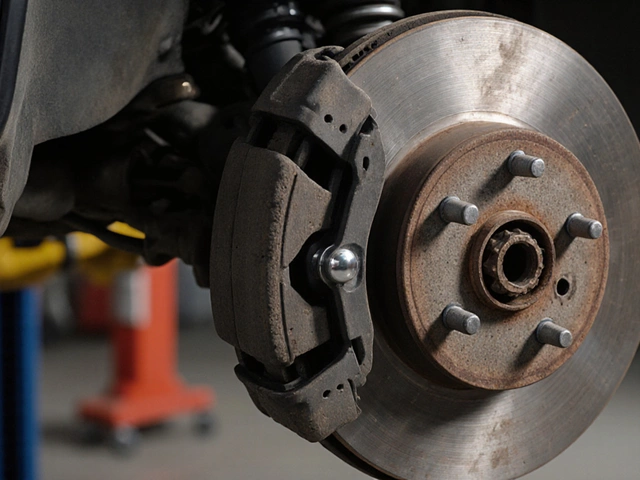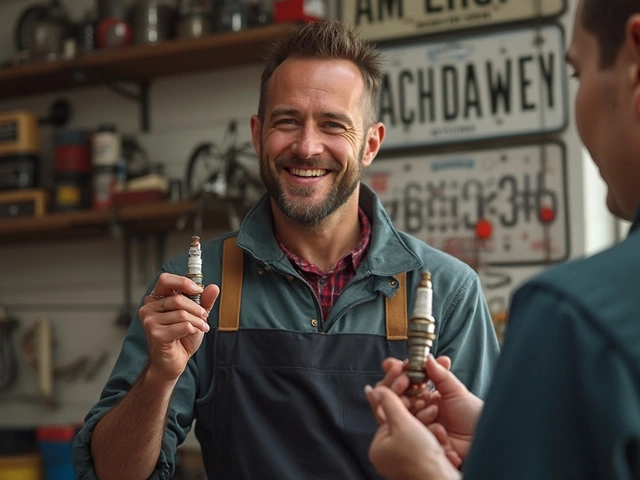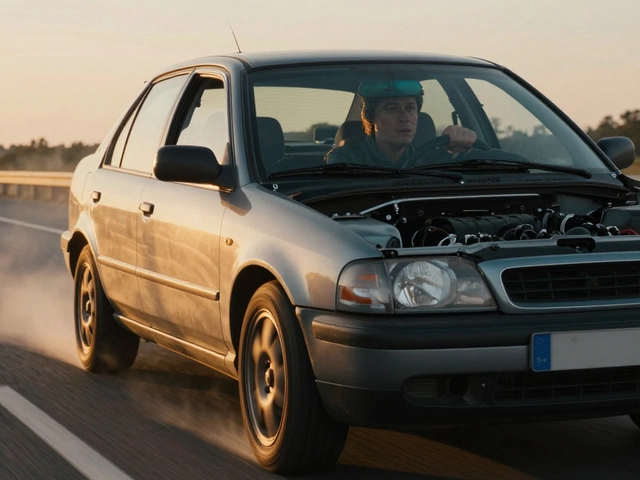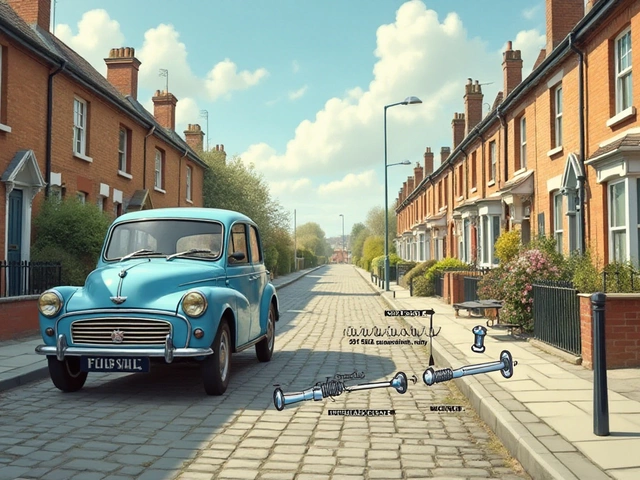Ever run over a gnarly pothole and felt your car drive weird after? You're not just imagining things—your suspension might have taken a hit. Bent suspension parts mess with the way your car handles, chews up your tires way faster, and, honestly, can make things downright dangerous if you keep driving like nothing happened.
If your ride starts pulling to one side, or your steering wheel feels off center, don’t just chalk it up to a rough road. Even a small bend in the wrong place can make your steering twitchy and your tires bald way before their time. Ignoring the signals usually means you’re signing up for a bigger repair bill (or worse, a close call on the road) down the line.
Most drivers never check their suspension unless there’s a noise, but that’s not enough. There are a few simple things you can do right now to figure out if something’s up—no need to be a car expert. Let’s zero in on what to watch for before it gets serious.
- Why Suspensions Get Bent
- Warning Signs You Can’t Ignore
- Quick Checks: What You Can Do at Home
- Parts Most Likely to Get Bent
- When to Visit a Mechanic
- Long-Term Damage: Why You Should Act Fast
Why Suspensions Get Bent
Most people don’t realize that their bent suspension can happen just from bad luck—one deep pothole or bump is sometimes all it takes. City streets are rough business for your suspension parts. The truth is, even rolling over a chunky speed bump too fast can tweak things out of shape, especially if your tires aren’t fully inflated.
But it's not just roads to blame. Here’s what usually puts your suspension in trouble:
- Accidents and crashes: Even a small fender bender can mess up alignment or actually bend things like control arms and tie rods.
- Big hits—curbs, potholes, or debris: Slamming one of your wheels into a curb or running over something solid at the wrong angle is a classic way to bend something underneath.
- Overloading: Loading your car way past what it’s built for puts extra stress on everything down there. Over time, it’s not just your springs that get tired—metal can warp from long-term abuse.
- Metal fatigue: Parts like ball joints and struts wear out slowly. When they finally give, they don’t always break clean—they can bend first.
Some stats for everyday folks: researchers from AAA found that U.S. drivers shell out roughly $3 billion a year on car repairs caused by busted and bent suspension setups from potholes alone. And mechanics often catch bent control arms or strut rods most often on cars that see a lot of city driving or work duty.
The main thing? Car maintenance isn’t just about oil changes. Keeping your suspension healthy keeps repairs cheap. Watch where you drive, don’t ignore warning sounds, and lay off on overloading your trunk if you want your parts to last longer.
Warning Signs You Can’t Ignore
Alright, let's get real about the weird stuff that happens when your bent suspension is messing with your car. Ignoring these warning signs can drag out your problems and jack up repair costs, so keep your eyes and ears open.
If you notice your car suddenly pulls to one side while driving straight, that’s a big red flag. Another classic? Your steering wheel points off-center even when your wheels look straight. You might also feel your steering fighting you or vibrating more than usual, especially after hitting a pothole or curb hard. Your car handling just won’t feel right—kind of sloppy, floaty, or twitchy.
Uneven tire wear is another dead giveaway. If one tire’s tread is wearing out way faster or the wear pattern just looks weird, don’t blame the tires. A suspension part is probably bent and throwing your alignment off. You might spot this when rotating your tires or during a quick glance: more bald patches on one side or feathered edges signal trouble brewing below.
Got clunks, rattles, or squeaks, especially when going over bumps? That’s your suspension crying out for help. Any new noises that pop up after a rough jolt are worth taking seriously. Sometimes, you might even notice the car sitting lower on one corner—yeah, that’s as bad as it sounds.
- Steering wheel won’t stay straight
- Pulling left or right
- Weird tire wear
- Clunks, rattles, or squeaks from under the car
- Car looks uneven or sags on one corner
- Steering feels loose, heavy, or shaky
Since about 7 out of 10 cars in the U.S. have some sort of suspension or alignment issue by 100,000 miles (car maintenance shops see this all the time), there’s no shame in double-checking yours. Spotting these signs early keeps you safer and helps you dodge bigger bills down the road.
Quick Checks: What You Can Do at Home
You don’t need any fancy gear or special skills to spot a bent suspension part at home. A handful of basic checks can flag most issues before they grow into something way pricier. Here’s what you can do right in your driveway.
- Park on Flat Ground: First, find a perfectly flat surface. Look at your car from the front and back. Does it sit level? One sagging corner is a huge red flag for a suspension problem.
- Check the Wheel Gap: Check the distance between your tire and the fender on each wheel. The gap should be nearly the same on both sides. If one side sits higher or lower, it could mean a bent or damaged suspension part.
- Inspect Your Tires: Uneven tire wear, like scalloping or extra wear on one edge, often points straight at a bent suspension or alignment problem. Run your hand across the tread—feel anything rough or lumpy? That’s never normal.
- Look Underneath: While you’re down there, peek under your car at the suspension arms and links. If something looks twisted, dented, or just different from the other side, that’s a clue. A flashlight can help spot fresh scrapes or cracks.
- Steering Wheel Test: Take a short, safe drive. Does the steering wheel sit straight when you’re going straight? If it’s off center or the car pulls to one side, your suspension could be at fault.
Out of all roadside breakdown calls in the U.S., about 13% come back to suspension or steering issues, making early checks a small effort that prevents huge headaches later.
Don’t skip these simple checks. If anything feels wrong, it’s better to find out now instead of waiting for something to break at the worst moment.
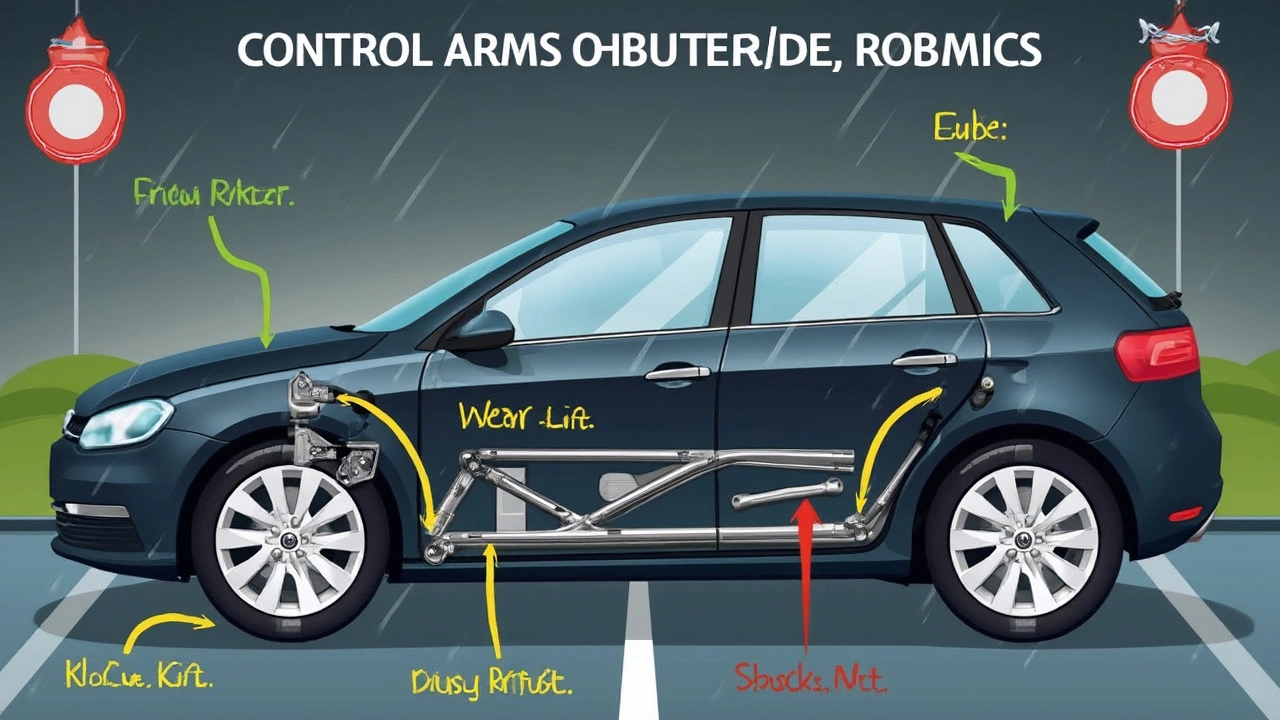
Parts Most Likely to Get Bent
If you think your bent suspension might be causing issues, you want to know which pieces take the most abuse. Not everything under there is equally fragile, but some parts just seem to attract problems—especially after hitting curbs or potholes at speed. Let’s break down the usual suspects so you know exactly where to look.
- Control Arms – These connect your wheels to the car’s frame. If a control arm is bent, your wheel can sit at a weird angle, making your vehicle pull or wobble. Control arms are a top reason behind uneven tire wear.
- Tie Rods – Tie rods help steer your wheels. Bent tie rods usually mean sloppy steering, lots of shaking, or your steering wheel not lining up right. Even a slight bend throws your alignment way off.
- Struts and Shocks – When these get bent, your car can bounce too much or sit lower on one side. You might also hear sketchy clunks going over bumps, which scream, “Time for a check!”
- Spindles and Knuckles – These pieces hold everything together at the wheel. If they’re bent, you’ll notice weird noises, harsh vibration, or your car drifting on straight roads. They’re tough but not unbreakable—especially after a big impact.
- Sway Bar Links – These keep your ride steady during turns. A bent link might make cornering feel loose or sloppy, kind of like your car is rolling too much.
Just so you get the full picture, here’s how often these suspension parts show up in repairs after an impact, based on what service shops report:
| Suspension Part | Chance of Damage (%) |
|---|---|
| Control Arms | 55 |
| Tie Rods | 30 |
| Struts/Shocks | 25 |
| Spindles/Knuckles | 15 |
| Sway Bar Links | 10 |
If you see any wonky tire angles, feel odd vibration at the wheel, or notice steering that’s less sharp than usual, start by checking these suspension parts. Sometimes it’s easy to spot a bent arm; other times, you’ll need a shop to do a proper inspection. Don’t ignore the warning signs—these parts rarely fix themselves, and they always get worse if you wait.
When to Visit a Mechanic
Not sure if it’s time to bring your car in? Here’s the deal: driving around with a bent suspension isn’t just uncomfortable—it can quickly snowball into way bigger issues. If you spot even one of these red flags, it’s smart to make that appointment sooner rather than later.
- Car pulls to one side: If your steering wheel fights you or you have to correct your line all the time, that spells trouble. It usually means something in the suspension parts got bent out of shape.
- Weird tire wear: Notice your tires are more worn on one edge? That’s classic bent suspension territory and messes with your car handling.
- Clunking or popping noises: Don’t ignore new sounds, especially after hitting a big bump or curb. Bends in control arms or sway bar links often show up as mystery noises.
- Visible damage: Sometimes, you can actually spot a control arm or tie rod that doesn’t line up right, or the wheel just looks wonky. Visual checks go a long way.
Can you DIY it? Only to a point. Some folks try to bend metal back themselves, but without the right tools, you risk making things worse. Shops have alignment racks and precise tools to measure if your suspension is actually straight. Mechanics check for hidden damage—sometimes even a tiny bend throws off the whole setup, and you won’t see that by eye alone.
According to AAA, alignment or suspension repairs are among the top five services requested after people hit potholes or curbs. Here’s a quick reference on when to go pro versus what you can safely leave for later:
| Problem | DIY Fix | See a Mechanic |
|---|---|---|
| Steering pulls/pulls to one side | No | Yes |
| Uneven tire wear | No | Yes |
| Clunking or popping noise | No | Yes |
| Visible bent metal | No | Yes |
| Slight vibration, no other symptoms | Maybe (check wheels/tires) | Maybe |
If the symptoms are minor—think barely-there vibrations—it might just be your tires. But as soon as you notice changes in handling or see actual bent suspension parts, it’s time for the pros. Waiting can wreck your ride’s handling and rack up a way bigger repair bill. Don’t gamble with your safety—a trustworthy mechanic can spot the real problem and fix it right.
Long-Term Damage: Why You Should Act Fast
Let’s get real for a minute—bent suspension parts don’t just mess up your car for a weekend, they start a chain reaction of bigger problems over time. When a bent suspension is left alone, your tires wear unevenly, your alignment gets worse, and every bump you hit stresses other expensive parts under your car. One part gets out of line and soon you could be looking at damaged shocks, struts, or even your steering rack—all stuff that’s way more costly than a simple fix right after an accident.
Here’s what tends to get worse the longer you wait:
- Tires: Uneven or rapid tire wear often starts with suspension issues. You might lose 30-40% of tire life just from bad alignment.
- Steering: That annoying pull or constant correction at the wheel doesn’t just disappear. It can lead to dangerous situations, especially at high speeds or sudden stops.
- Other Parts: A bent arm or link puts extra pressure on ball joints, bushings, and wheel bearings. It’s like a domino effect—pretty soon, more stuff needs replacing.
If you’re thinking about resale value, here’s a fact: Mechanics spot bent suspension during routine inspections, and buyers will use it to drop your car’s price way lower than expected. Even worse, some insurance companies may not cover future damage if you ignored obvious signs now.
Just look at how ignoring bent suspension can hit your wallet:
| Issue | Average Extra Cost (USD) |
|---|---|
| 1 set of new tires (replaced early) | $600-$1200 |
| Additional suspension parts damage | $400-$1000 |
| Wheel bearings/steering rack | $350-$1000 |
Point is, acting fast isn’t just about smoother rides—it’s about saving money and avoiding bigger headaches down the road. If you spot signs of a bent suspension, fix it now instead of waiting for a sudden surprise (and an empty bank account) later.

